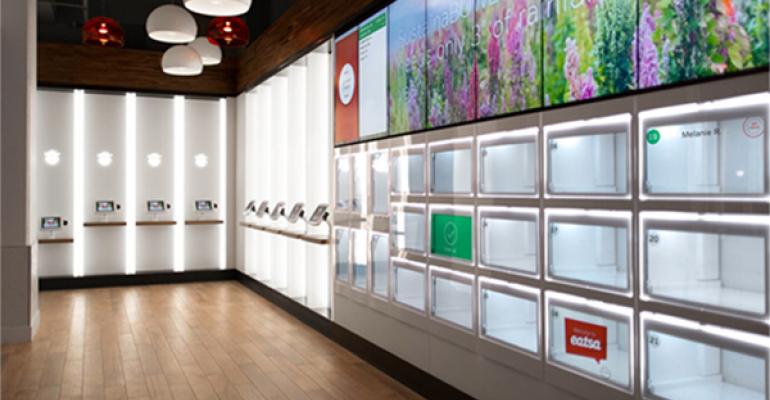If you hope emerging technology might significantly reduce your restaurant’s operating overhead, keep your eye on Eatsa. It’s a tech-driven operation in San Francisco designed from the ground up to keep labor costs microscopically low yet simultaneously alleviate choke points—long lines to place orders; slow checkout at the cashier—that plague other fast casual restaurants.
The Eatsa experience works this way. An arriving customer steps into space that has a futuristic look-and-feel and heads for a bank of iPad kiosks that line the wall. He or she swipes a credit card (cash is not a option), inputs their order and waits—hopefully no more than two minutes—to receive their food.
This ordering and payment routine is nothing special: other restaurants offer similar options. The breakthrough here is Eatsa’s Automat-like method of delivering food to customers.
“A first of its kind automated food pick-up system features a collection of glass door ‘cubbies,’" the company says. “When a customer's meal is ready, the cubby door transforms to display personalized graphics and presents the food at the touch of a button. This automated system ensures every customer receives their food when and how they want it.”
With no human involvement required for order-taking, payment or delivery of food to the customer, Eatsa’s labor cost for the front of the house approaches zero. Check out a video that shows the process at work.
Cofounder Scott Drummond tells Fast Company the goal for the back of the house is to one day have robots do most of the order assembly. That would remove another layer of labor costs from the operation.
Fast casual operators for whom throughput and labor cost are key metrics are going to be envious of what Eatsa has going on here. But they won’t be wondering why they didn’t think of it first.
That’s because Eatsa’s food offerings are limited to an all-quinoa-bowl vegetarian menu. It’s a great choice because the meals are healthful, vibrantly flavored, easily customizable and can be assembled in a hurry. Even better, because quinoa bowls are meat-free, they can be sold at an affordable price while food costs remain low.
But not everyone wants a quinoa bowl, even if they are protein-packed because quinoa is a compete protein. In a way, another of Eatsa’s breakthroughs is making quinoa craveable to the masses.
The Eatsa menu offers a choice of four quinoa bowls served hot and four quinoa salad bowls served cold. Each sells for $6.95.
The bowls include the No Worry Curry, a Harvest Bowl and the Bento Bowl (stir fry-style quinoa, edamame, crispy wonton strips, teriyaki sauce, miso portabello, apple-cabbage slaw). Eatsa goes head-to-head against Chipotle with a Burrito Bowl whose ingredients include guacamole, salsa fresca, queso Mexicano, asada portabello, grilled corn, warm lemon-herb toasted quinoa, tortilla chips and seasoned pinto beans.
The salad lineup offers Balsamic Beet, The Mediterranean, the Big Chop and a Smokehouse Salad made with white cheddar, mixed greens, crispy onion strings, BBQ portabello, tomato, grilled corn, cucumber, BBQ ranch dressing, pickled onions and toasted red quinoa.
Seven of the eight choices have a dairy component, leaving vegan customers with just one choice—the Bento Bowl. However, guests can customize any meal to suit their personal taste. The menu also offers three sides (house potato chips, seasonal fresh fruit, chips and guacamole) and six house-branded beverage options plus two water choices. Notably, Eatsa appears to gouge it customers less on beverage pricing than some other fast casual operations have chosen to do.
Eatsa opened its doors on Aug. 31 and has been jumping ever since. Customer reviews on Yelp have been ecstatic despite the all-quinoa bowl menu. On the operations front, the goal is to produce all orders in two minutes, but Eatsa isn’t quite there yet. Some customers remark they have experienced sizable waits.
Help is on the way. Customers will soon be able to use the Eatsa app to submit their order via their smartphone and specify a pickup time. Mobile location tracking technology will enable Eatsa to put each customer’s meal in a cubby just as that customer walks through the door.
So will this concept succeed? The first unit is located in San Francisco’s SoMa area, just off the Embarcadero. The immediate neighborhood is packed with high tech-worker types for whom a restaurant that serves tasty vegetarian food using a gee-whiz technology format almost guarantees Eatsa will be a hit. The founders plan to open a second location in suburban mall-type location in Southern California soon. That will be a true proof of concept for Eatsa.
Keenwawa, Eatsa’s parent company, has big plans from there.
"Our goal is to test the concept and then scale rapidly, getting into different markets as quickly as possible," Drummond says. The company argues that if you look at what why customers eat at traditional fast food operations, the Eatsa approach makes sense.
“So why do they go (to QSRs)? Because they are drawn to the promise of speed, the perception of value, and the craveability, delivered through food with scientifically crafted addictive flavors that damage nutrition.
“Now imagine how easy it would be to change this: re-engineer the experience, develop software to drive efficiency, use food science to create food that is incredibly craveable while being truly nutritious. The result will be Fast Food that is faster, cheaper, tastier and healthier. That’s our mission. Better food for more people, and better for the planet in the process.”
We’ll find out how well this concept will play in the marketplace as it opens more locations. But in the meantime, those who want to see what the future of the restaurant industry could be might want to take a look at Eatsa.





